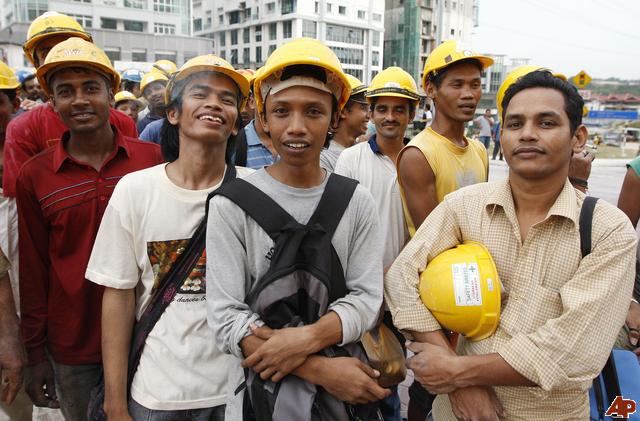-
Advocacy Theme
-
Tags
- Abortion
- Adoption
- Caregiving
- CEDAW
- Disability
- Domestic Violence
- Domestic Workers
- Harassment
- Healthcare
- Housing
- International/Regional Work
- Maintenance
- Media
- Migrant Spouses
- Migrant Workers
- Muslim Law
- National budget
- Parental Leave
- Parenthood
- Polygamy
- Population
- Race and religion
- Sexual Violence
- Sexuality Education
- Single Parents
- Social Support
- Sterilisation
- Women's Charter
AWARE Responds To The Population Paper
February 2nd, 2013 | News, Older People and Caregiving, Poverty and Inequality, Press Release
2 February 2013
FOR IMMEDIATE RELEASE
“Population Paper – Why No Public Consultation and Considerations of Social Justice?”
It is commendable that the Government has released a Population Paper setting out its proposed population strategy from now till 2030. This forward planning and transparency is most welcome.
However, AWARE is concerned that the Government has once again focused on economic growth, rather than the well being of its people, as the main determinant of Singapore’s population size and rate of growth.
AWARE is also disappointed that there is no provision for thorough public consultation on the proposed population strategy. Why is the Government targeting for the Paper to be endorsed by Parliament within just a week of its release? This is unduly hasty given the major implications of the proposed strategy. Singaporeans have in the last few days shown their anxiety and unhappiness about these implications. More time must be given for people to ask questions and express their concerns.
The Paper indicates that to achieve certain GDP targets, Singapore’s population in 2020 must be 6.5 million and reach 6.9 million by 2030.
 AWARE believes that the primary objective of Singapore’s population policy should not be economic growth per se, but the well being of people in Singapore. GDP growth can be one factor, but not the ultimate factor in population considerations. The critical question that the Paper should have addressed is “What is the optimum population to achieve maximum well-being for all members of Singapore society?”
AWARE believes that the primary objective of Singapore’s population policy should not be economic growth per se, but the well being of people in Singapore. GDP growth can be one factor, but not the ultimate factor in population considerations. The critical question that the Paper should have addressed is “What is the optimum population to achieve maximum well-being for all members of Singapore society?”
Well-being goes beyond GDP growth. It encompasses a broader range of considerations including fulfilling jobs and rising incomes across-the-board, economic security, equitable distribution of wealth, universal access to affordable healthcare and education.
By focusing solely on GDP growth, The Paper fails to mention, let alone address, issues of inequality and lack of social mobility. This omission is worrying considering that the last ten years of liberal immigration policy has resulted in wage erosion at the lower end and given rise to a widening Gini Coefficient and wealth disparities.
Of greater concern is what the omission reflects about the Government’s general approach to managing Singapore. The many appeals for a fairer, more equitable and less materialistic society made by Singaporeans in the National Conversation and the public consultation on population issues, including AWARE’s submissions, seem to have fallen on deaf ears.
Despite receiving clear signals that public sentiment on this issue is strong, the Government is fixated on GDP growth through population expansion. The cost to society can already be seen in the claustrophobia and diminished quality of life that many Singaporeans complain about.
The proposed population strategy raises many issues which require consideration and debate (see Annex A for some issues that AWARE is concerned about). The research that must have gone into this is not reflected in this Paper. Many different scenarios must have been studied. The Government should make all the research and arguments available to enable a thorough and rigorous discussion of this issue.
We urge the Government to conduct a proper public consultation on this Paper and to share the research and data behind the Paper, before seeking endorsement of the proposed policy in Parliament. Members of Parliament should be given the time to get the views of their constituents before they debate and vote on the Paper.
What is needed is rigorous debate and shared ownership of the decisions made about Singapore’s future.
————————-
AWARE had made two submissions to the National Population and Talent Division on Population, Marriage and Parenthood issues. For the full text of our submissions, please refer to:
https://aware.org.sg/wp-content/uploads/AWAREs-population-recommendations-to-NPTD_31Oct12.pdf
https://aware.org.sg/wp-content/uploads/Suggestions-to-NPTD_update_24-July.pdf
Annex A
Social Justice
What will the impact of a 2% growth in the foreign labour force have on wages at the lower end? How will the Government ensure that the Gini Coefficient and wealth disparities will not continue to widen?
While the majority of Singaporeans may be in PMET jobs, what about those that aren’t? What support will there be for those that find themselves in the lower end jobs?
Will the government consider providing the following social supports to mitigate the effects of a more crowded and competitive place?
a) Unemployment insurance
b) Universal healthcare through insurance with government subsidizing the premiums of those who cannot afford this
c) Universal childcare benefits that do not favour the rich e.g. tax reliefs / exemptions
Impact of Higher Population Density on Families
High density living gives rise to feelings of insecurity and increased pressure and competition. This will in turn have an impact on individuals’ fertility decisions. Has the Government factored in what impact higher population density will have on the Total Fertility Rate? What measures will be taken to ensure that the goal of Building a Strong Singaporean Core is not adversely affected by high population density. What assumptions about Total Fertility Rate is the government making when doing its projections?
Getting More Residents in the Workforce
At any one time, more than 30% of females are out of the workforce. A lot more can be done to get them into the workforce, which will reduce the need for importing foreign labour.
The Paper mentions that the Government will try to get more residents into the workforce but does not set any targets for this.
What assumptions have been made about this factor?
Ageing Population
The paper refers to ‘Declining Old Age Support Ratio’ as the number of citizens between 20-64 that supports a citizen above 65
Why should only citizens provide support for older people? Is this an accurate way of looking at it? Should we not take into account the total workforce (including foreigners) rather than just citizens? If the foreign workforce is included, the support base would be much stronger.
If 36% of our workforce is foreign will we be overly reliant on foreign workers? Would this dependence be healthy and sustainable? We have a responsibility to protect and uphold the dignity of the foreign workers who come here to seek a living, and contribute much to our economy and society. How do we ensure that we provide decent conditions of work so that we become a country of choice for foreign workers?
Alternative Scenarios
The Paper gives one option – that of 3-5% growth between now and 2020, and thereafter 2 – 3% growth between 2020 and 2030. Why has the Government chosen this particular model? What about other scenarios?
One thought on “AWARE Responds To The Population Paper”
Comments are closed.





We have been silent for too long, Well said AWARE.